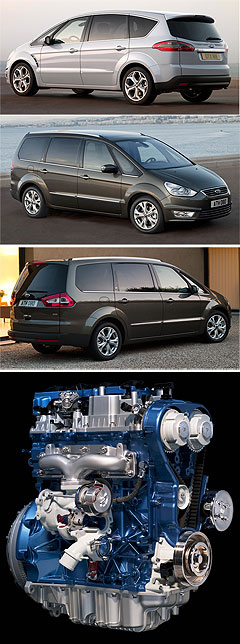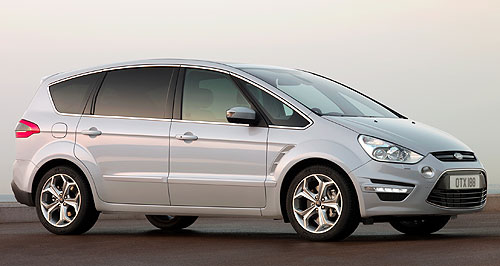Make / Model Search
Future models - Ford - FalconFord Falcon set for 20 per cent fuel gainEcoBoosted: Ford of Europe's S-Max is one of two people-movers to get the 2.0-litre EcoBoost four-cylinder engine that will also be offered in the Ford Falcon by 2011. Ford’s EcoBoost four-cylinder debuts in Europe with 8.1L/100km fuel efficiency17 Dec 2009 FORD’S planned four-cylinder Falcon is set to make fuel-efficiency gains of about 20 per cent over the current 4.0-litre six-cylinder models, judging from figures quoted for the first large-car application of the 2.0-litre EcoBoost engine in Europe. If the figures translate to the Australian application, the 2011 EcoBoost Falcon will be well placed to out-point not only its most thrifty local six-cylinder rivals, Holden’s 3.0-litre Commodore and the Toyota Aurion, but also the standard four-cylinder Toyota Camry. The 3.0-litre Commodore has a combined figure of 9.3 litres per 100km, while Toyota local contenders, the Aurion and Camry, have figures of 9.9L/100km and 8.8L/100km respectively. However, the four-pot Falcon will still fall short of the new Camry Hybrid, which Toyota claims will achieve an official combined fuel figure in the low sixes when it is launched in February.  From top: Ford S-Max, Galaxy and EcoBoost engine. From top: Ford S-Max, Galaxy and EcoBoost engine.According to data released by Ford this week, the EcoBoost STCi engine – to make its debut in Ford of Europe’s Mondeo-based S-Max and Galaxy people-movers at the Brussels motor show in January – returns a combined fuel consumption figure of 8.1L/100km, compared with the Ford Falcon’s best current figure of 9.9L/100km in models fitted with the upmarket six-speed automatic transmission. The fleet-friendly Falcon XT base model, with its standard five-speed auto transmission, is thirstier, returning a combined fuel consumption test figure of 10.5L/100km. Although Ford Australia cautions that the European version of the engine will not necessarily be the same as the Falcon unit – which will almost certainly have more power than the 149kW quoted for S-Max and Galaxy – much of the technology of turbo-charged, direct-injection engine is set to arrive in the four-cylinder Falcon to be launched in 2011. The Falcon will be the first rear-drive application of the 2.0-litre EcoBoost engine which Ford is rolling out globally, along with 1.6-litre version and a 3.5-litre V6. The latter is being pitched as a V8 alternative in cars such as the Taurus, Flex and Lincoln MKS and MKT. The twin European people-movers will get the 2.0-litre EcoBoost engine in the first quarter 2010 as part of a facelift to be revealed on January 16 in Brussels, near Ford’s Genk plant that makes them alongside the Mondeo. The engine will be offered standard with Ford’s latest Powershift dual-clutch transmission – a gearbox that is almost certain to be matched to the engine in its Falcon guise to maximise fuel efficiency. At 1600kg, the S-Max is about 100kg lighter than the current six-cylinder Falcon, which weighs in at 1704kg, but that bulk will be pared considerably, courtesy of the smaller all-aluminium engine and lighter transmission, bringing it close to the S-Max’s mass. While Ford Australia has not given specifics of power and torque outputs for the Falcon four-cylinder engine, Ford is clearly shaping up to produce more than one 2.0-litre EcoBoost engine variant with a number of performance levels for a number of applications. While the engine in the S-Max generates 149kW and 300Nm, Ford’s vice-president of global powertrain engineering Barb Samardzich announced a 172kW/325Nm version in July. This North American variant – a more likely starter in the Falcon than the Euro – is said to deliver 20 per cent fuel efficiency improvements over large six-cylinder engines, which is in line with a low 8.0L/100km fuel figure for the Australian large car. Even with the higher output of the North American engine, peak power figures would be short of all local six-cylinder rivals in the 190-210kW range, but ahead of the 117kW output of the standard four-cylinder Camry. However, the low-boost turbo and direct-injection characteristics of the EcoBoost engine are said to be tuned to maximise low-end torque, meaning it could well surprise in launch feel and urban performance.  Read more18th of September 2009  Frankfurt show: Ford’s EcoBoost future revealedFalcon’s 2011 four-cylinder engine to have at least 147kW of power and low-end mumbo11th of September 2009  Ford tests rear-drive 4cyl engine for FalconCountdown begins to Ford’s EcoBoost future as it starts 4cyl test regime11th of August 2009  Ford to make call on next Falcon in 2011Current Falcon to soldier on until 2015 while Ford mulls its future27th of July 2009  Ford Falcon EcoBoostedFalcon to plug in to global Ford plan with direct-injection 2.0-litre EcoBoost27th of July 2009  Falcon ‘four’ guns for fleetsFord aims to recapture fleet business with fuel-friendly EcoBoost four-cylinderAll future models Alfa Romeo Alfa Romeo Abarth Abarth Alpine Alpine Alpina Alpina Audi Audi Aston Martin Aston Martin BMW BMW Bentley Bentley Chery Chery Brabham Brabham Chrysler Chrysler Chevrolet Chevrolet Cupra Cupra Citroen Citroen DS DS Dodge Dodge Fiat Fiat Ferrari Ferrari Foton Foton Ford Ford Great Wall Great Wall FPV FPV Haval Haval GWM GWM Honda Honda Holden Holden Hummer Hummer HSV HSV Infiniti Infiniti Hyundai Hyundai Jaguar Jaguar Isuzu Isuzu Kia Kia Jeep Jeep Land Rover Land Rover Lamborghini Lamborghini Lexus Lexus LDV LDV Mahindra Mahindra Lotus Lotus Mazda Mazda Maserati Maserati Mercedes-AMG Mercedes-AMG McLaren McLaren MG MG Mercedes-Benz Mercedes-Benz Mitsubishi Mitsubishi Mini Mini Opel Opel Nissan Nissan Peugeot Peugeot Pagani Pagani Proton Proton Porsche Porsche Renault Renault Ram Ram Rover Rover Rolls-Royce Rolls-Royce Skoda Skoda Saab Saab SsangYong SsangYong Smart Smart Suzuki Suzuki Subaru Subaru Toyota Toyota Tesla Tesla Volvo VolvoMotor industry news |
Click to shareFord modelsResearch Ford All future models Alfa Romeo Alfa Romeo Abarth Abarth Alpine Alpine Alpina Alpina Audi Audi Aston Martin Aston Martin BMW BMW Bentley Bentley Chery Chery Brabham Brabham Chrysler Chrysler Chevrolet Chevrolet Cupra Cupra Citroen Citroen DS DS Dodge Dodge Fiat Fiat Ferrari Ferrari Foton Foton Ford Ford Great Wall Great Wall FPV FPV Haval Haval GWM GWM Honda Honda Holden Holden Hummer Hummer HSV HSV Infiniti Infiniti Hyundai Hyundai Jaguar Jaguar Isuzu Isuzu Kia Kia Jeep Jeep Land Rover Land Rover Lamborghini Lamborghini Lexus Lexus LDV LDV Mahindra Mahindra Lotus Lotus Mazda Mazda Maserati Maserati Mercedes-AMG Mercedes-AMG McLaren McLaren MG MG Mercedes-Benz Mercedes-Benz Mitsubishi Mitsubishi Mini Mini Opel Opel Nissan Nissan Peugeot Peugeot Pagani Pagani Proton Proton Porsche Porsche Renault Renault Ram Ram Rover Rover Rolls-Royce Rolls-Royce Skoda Skoda Saab Saab SsangYong SsangYong Smart Smart Suzuki Suzuki Subaru Subaru Toyota Toyota Tesla Tesla Volvo VolvoMotor industry news |











Facebook Twitter Instagram